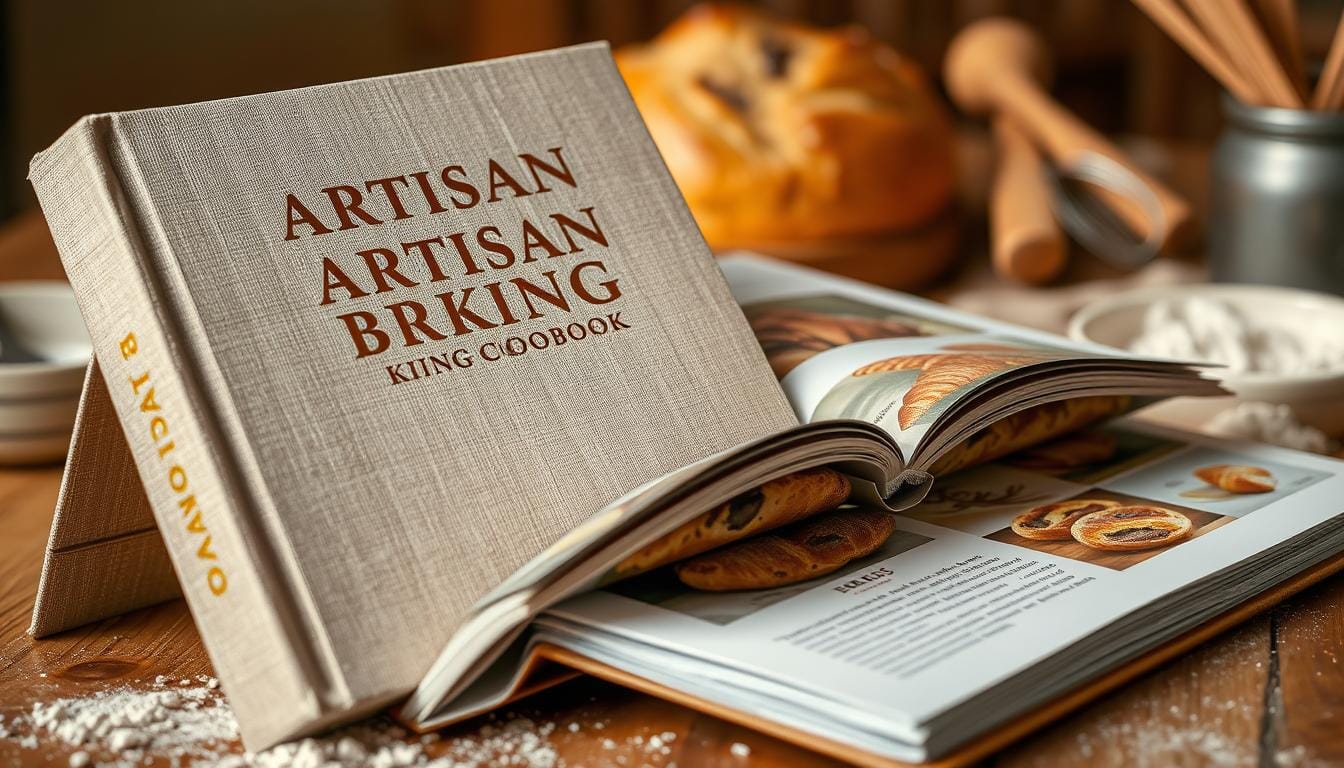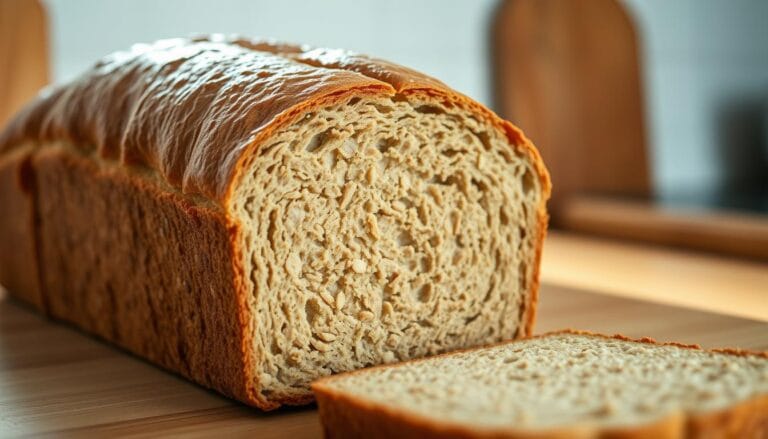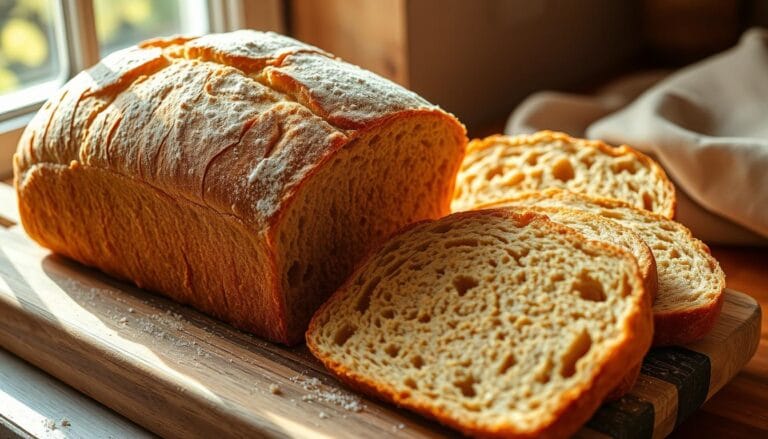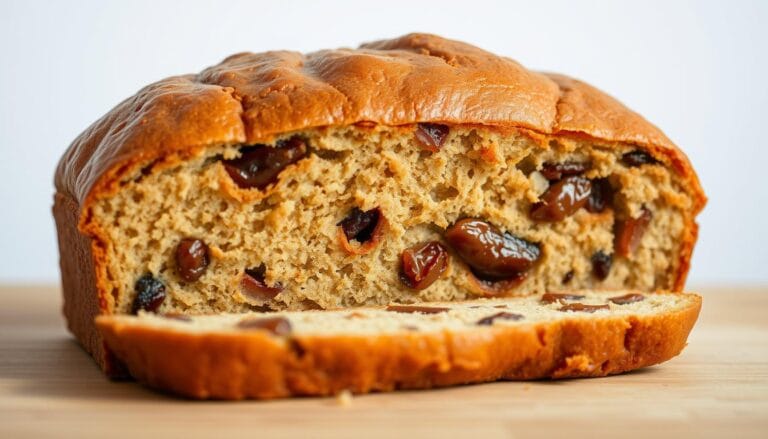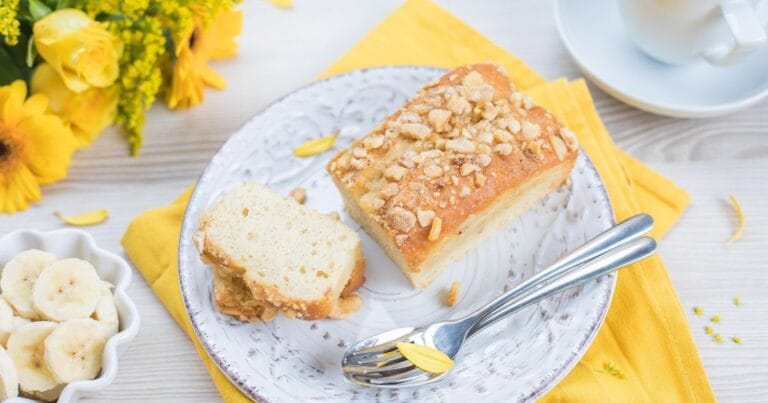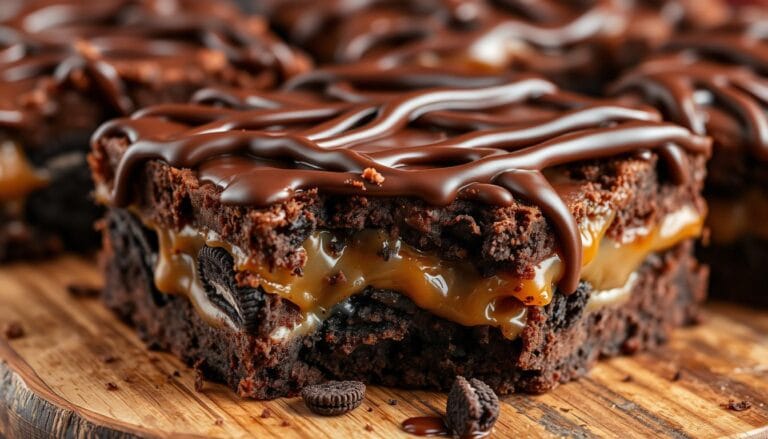Bread Cookbook: Bake Perfect Loaves at Home
Every kitchen has a story, and mine started with the smell of fresh bread. I watched my grandmother knead dough with her hands. She turned simple ingredients into golden, crusty loaves that filled our home with joy. This sparked my love for bread baking.
Now, home bakers can make professional-level bread thanks to the internet. A good bread cookbook is more than just recipes. It’s a way to make bakery-quality bread at home. Whether you’re new or experienced, the right cookbook can improve your skills and reveal bread secrets.
A great bread cookbook, like Maurizio Leo’s “The Perfect Loaf,” is essential. It teaches you about fermentation and shaping. These books make complex baking easy, so anyone can make delicious, handcrafted loaves.
Table of Contents
Key Takeaways
- Bread cookbooks bridge the gap between home and professional baking
- Understanding fundamental techniques is crucial for bread success
- Quality ingredients and proper techniques transform simple recipes
- Baking bread is both a science and an art
- Personal passion drives culinary creativity
Essential Tools and Ingredients for Artisan Bread Making
Making delicious artisan bread is more than just passion. You need the right tools, ingredients, and knowledge. This guide will turn your kitchen into a pro bread-making space.
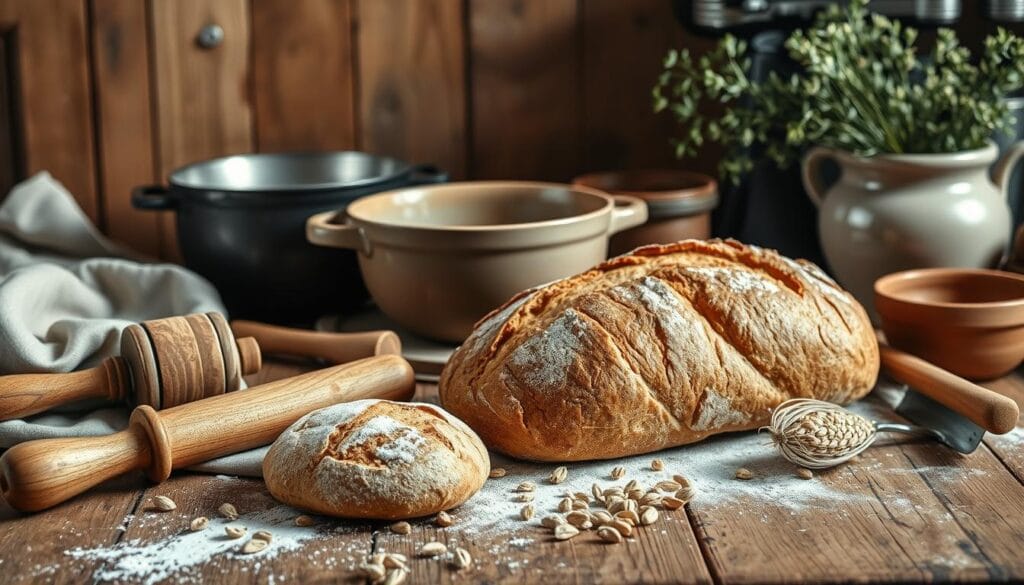
Creating amazing artisan bread begins with the right tools and ingredients. The quality of your flour and leavening agents affects the taste and texture of your loaf.
Professional Baking Equipment Must-Haves
- Dutch oven for perfect crust development
- Digital kitchen scale for precise measurements
- Proofing basket for ideal dough shape
- Sharp bread lame for scoring
- Thermometer for monitoring dough temperature
Quality Flour Selection Guide
| Flour Type | Protein Content | Best Use |
|---|---|---|
| Bread Flour | 12-14% | High-protein bread with strong gluten structure |
| All-Purpose Flour | 10-12% | Versatile flour for various bread types |
| Whole Wheat Flour | 14% | Nutrient-rich, denser breads |
Leavening Agents and Their Properties
Knowing about bread leavening is key for light, airy loaves. Sourdough starters and commercial yeasts each add special qualities to your bread.
- Sourdough Starter: Provides complex flavor and natural fermentation
- Active Dry Yeast: Consistent and reliable leavening agent
- Instant Yeast: Quick-acting and easy to incorporate
Invest in quality tools, choose the right flour, and try different leavening methods. This will improve your artisan bread-making skills.
Understanding the Science Behind Bread Baking
Bread making is more than just mixing ingredients. It’s about turning simple parts into tasty loaves. Knowing the science behind it can make your baking better.
Gluten is key to good bread. When flour and water mix, proteins form an elastic network. This network traps gas bubbles, making your bread rise and have a great texture.
- Protein content in flour impacts gluten strength
- Kneading helps align protein molecules
- Temperature affects enzyme activity
Fermentation is also vital. Yeast eats sugars, making carbon dioxide and air pockets. The longer it ferments, the more complex the flavor.
| Fermentation Factor | Impact on Bread |
|---|---|
| Temperature | Controls yeast activity and flavor development |
| Hydration | Influences dough elasticity and fermentation speed |
| Salt | Regulates yeast growth and strengthens gluten |
Learning these scientific basics can improve your bread making. Each ingredient is important for that perfect loaf.
Mastering Sourdough Starter Creation and Maintenance
Sourdough baking is an art that starts with a healthy starter. Unlike commercial yeast, a sourdough starter gets wild yeasts and bacteria from the air. It turns simple ingredients into a living, breathing culinary world.
Starting with sourdough baking needs patience and knowledge. Your starter is a mix of flour, water, and microorganisms. It’s the heart of your bread-making journey.
Building Your First Starter
Making a sourdough starter is easier than you think. Here’s a simple way to do it:
- Use equal parts whole wheat flour and all-purpose flour
- Mix with room temperature water
- Keep your mixture in a warm, consistent environment
- Discard and refresh daily to develop strong fermentation
Feeding Schedule and Storage Tips
Feeding your starter regularly is key in sourdough baking. It needs constant care to stay active and healthy:
- Feed your starter at the same time each day
- Use a 1:1:1 ratio of starter, flour, and water
- Store in a glass container with a loose lid
- Refrigerate if not baking frequently
Troubleshooting Common Starter Issues
Even experienced sourdough bakers face challenges. Look out for these signs:
- Weak bubbling: Means your starter needs more feeding
- Unusual odors: A healthy starter smells pleasantly sour
- Liquid separation: Known as hooch, it means your starter is hungry
Sourdough baking gets better with practice. Each batch of starter brings you closer to mastering this ancient bread-making technique.
Professional Bread Cookbook Techniques and Methods
To improve your bread making, learn professional methods. A good bread cookbook shares secrets for making loaves like restaurants. You can do it all in your kitchen.
Professional bread making is more than just recipes. It’s about the science of fermentation, hydration, and dough development. Your cookbook will teach you these advanced techniques used by pros:
- Autolyse method for improved gluten development
- Stretch and fold technique for better dough structure
- Precise temperature control during fermentation
- Understanding hydration levels for different bread styles
Getting good at bread making means focusing on details. Temperature is key for fermentation. Professional bakers know that keeping the temperature steady is crucial for texture and taste.
Your cookbook should teach you to read dough signals. Knowing when dough is ready helps make bread with richer flavors and textures. Professionals look for visual and touch cues to know when dough is just right.
Creating amazing bread takes practice and understanding the science behind it. Start with small batches and watch how different methods change your bread. This will help you get better.
Artisan Bread Shaping and Scoring Secrets
Learning to shape and score bread turns a simple loaf into a masterpiece. These skills make your bread look great and taste even better. Professional bakers see bread shaping as an art that needs practice and skill.
Your bread shaping journey starts with basic techniques that make home baking better. Each bread type needs its own shaping method. This affects the bread’s look and feel.
Basic to Advanced Shaping Methods
Good bread shaping involves a few key steps:
- Develop proper dough tension
- Use gentle folding techniques
- Create symmetrical shapes
- Practice consistent handling
From round boules to long batards, each shape needs special hand movements. Gentle handling keeps the dough’s gas bubbles intact.
Decorative Scoring Patterns
Bread scoring is more than just looks. It lets the bread grow in the oven, making beautiful patterns. Skilled bakers use sharp lames to make detailed designs.
- Simple cross pattern
- Wheat stalk design
- Geometric triangular cuts
- Spiral scoring technique
Creating the Perfect Crust
A perfect crust comes from the right baking conditions. Steam in the beginning helps make the crust crisp and golden. Bakers suggest preheating stones and using spray bottles for steam.
By mastering bread shaping and scoring, you’ll make your home baking amazing. You’ll create bread that looks stunning and tastes incredible.
Global Bread Recipes and Variations
Exploring global baking recipes shows the amazing variety of artisan bread traditions worldwide. Each culture adds its own flavors, techniques, and ingredients to bread making. This turns simple ingredients into culinary wonders.
See how different places make their own special breads. These breads use local ingredients and cooking ways. For example, French baguettes and Indian naan are more than food; they’re cultural expressions.
- French baguettes: Crispy exterior, soft interior
- Italian ciabatta: Airy holes, olive oil richness
- German pretzels: Distinctive twisted shape
- Indian naan: Tandoor-baked flatbread
Start your bread-baking journey by trying these global traditions. You can make authentic-inspired breads with your own twist. This way, you can enjoy the best of both worlds.
| Region | Bread Type | Unique Characteristics |
|---|---|---|
| France | Baguette | Long, thin shape with crisp crust |
| Italy | Ciabatta | Large air pockets, rustic appearance |
| Germany | Pretzel Bread | Salt-crusted, dark brown exterior |
| India | Naan | Soft, pillowy texture with charred spots |
Try these international baking recipes to grow your artisan bread skills. Each loaf shares a story of culinary heritage and creativity from around the world.
Sweet and Enriched Bread Specialties
Discover the joy of sweet and enriched baking recipes. They turn simple bread into amazing culinary experiences. These recipes boost your baking skills, combining texture, flavor, and creativity.
Sweet breads mix pastry and bread-making magic. Your recipes can create rich, decadent treats. These go beyond regular loaves, making simple ingredients unforgettable.
Brioche and Babka Mastery
Learn to make luxurious doughs for gourmet baking. Brioche and babka need special techniques for their tender crumb and rich flavors.
- Use high-fat butter for maximum richness
- Knead dough until smooth and elastic
- Allow extended rising time for complex flavors
Festive Holiday Breads
Bring cultural traditions to life with holiday breads. From Italian panettone to Greek tsoureki, these breads share stories through their ingredients and methods.
Specialty Filling Combinations
Try creative fillings to make your baking stand out. Mix chocolate-hazelnut, cinnamon-apple, or savory herb-cheese fillings. They’ll surprise and delight everyone.
- Chocolate and nut combinations
- Fruit and spice pairings
- Savory cheese and herb blends
Troubleshooting Common Bread Baking Problems
Mastering bread making takes patience and problem-solving skills. Every home baker faces challenges that can make or break their perfect loaf. Knowing how to solve common bread baking issues will improve your baking skills.
Spotting dough problems early can save your bread. Here are key strategies for home bakers:
- Recognize signs of underproofed dough: Dense, compact texture with minimal rise
- Detect overproofed dough: Flat, collapsed appearance with minimal structure
- Understand potential causes of poor oven spring
- Learn to adjust hydration levels for optimal bread texture
When your bread doesn’t rise right, many things could be wrong. Yeast quality, water temperature, and ingredient measurements are key. Check your yeast’s expiration date and make sure it’s fresh and active.
Temperature control is also vital in bread baking. Your kitchen’s temperature affects dough development. Keep your proofing area warm and draft-free for better fermentation and rise.
- Maintain consistent room temperature around 75-80°F
- Use a proofing box or warm oven for optimal conditions
- Watch for visual cues of proper dough development
By understanding these techniques, you’ll turn baking failures into learning chances. Practice, observe, and be ready to adjust. This will help you make stunning, delicious homemade bread.
Conclusion
Turning your kitchen into a pro bread bakery starts with passion and practice. Your bread baking oven is key to making artisan loaves like those from fancy bakeries. Every recipe you try teaches you new techniques, boosting your confidence and skill with each loaf.
The art of bread making is about loving the imperfections and learning from each try. You’ll learn about flour textures, fermentation, and oven settings. Books like “The Perfect Loaf” guide you, but your unique touch makes each loaf special.
Professional bakers know bread making is a craft that needs patience and dedication. You’ll find that practice is more important than getting it right the first time. Your skills will grow with each loaf, turning simple ingredients into amazing dishes that warm your table.
Bread baking is a journey of discovery. Keep trying new recipes, techniques, and flavors. Your kitchen is a place to experiment, and each loaf is a chance to learn and enjoy the magic of bread making.

